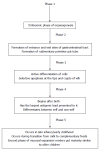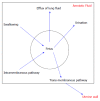Amniotic fluid: Source of trophic factors for the developing intestine
- PMID: 26909227
- PMCID: PMC4753188
- DOI: 10.4291/wjgp.v7.i1.38
Amniotic fluid: Source of trophic factors for the developing intestine
Abstract
The gastrointestinal tract (GIT) is a complex system, which changes in response to requirements of the body. GIT represents a barrier to the external environment. To achieve this, epithelial cells must renew rapidly. This renewal of epithelial cells starts in the fetal life under the influence of many GIT peptides by swallowing amniotic fluid (AF). Development and maturation of GIT is a very complex cascade that begins long before birth and continues during infancy and childhood by breast-feeding. Many factors like genetic preprogramming, local and systemic endocrine secretions and many trophic factors (TF) from swallowed AF contribute and modulate the development and growth of the GIT. GIT morphogenesis, differentiation and functional development depend on the activity of various TF in the AF. This manuscript will review the role of AF borne TF in the development of GIT.
Keywords: Amniotic; Development; Factors; Fluid; Gastrointestinal; Tract; Trophic.
Figures



Similar articles
-
Systemic and luminal influences on the perinatal development of the gut.Equine Vet J Suppl. 1997 Jun;(24):40-50. doi: 10.1111/j.2042-3306.1997.tb05077.x. Equine Vet J Suppl. 1997. PMID: 9355801 Review.
-
Host factors in amniotic fluid and breast milk that contribute to gut maturation.Clin Rev Allergy Immunol. 2008 Apr;34(2):191-204. doi: 10.1007/s12016-007-8032-3. Clin Rev Allergy Immunol. 2008. PMID: 18330727 Review.
-
Regulation of gastrointestinal growth in fetal sheep by luminally administered insulin-like growth factor-I.J Endocrinol. 1997 Jan;152(1):29-38. doi: 10.1677/joe.0.1520029. J Endocrinol. 1997. PMID: 9014837
-
The fetal gastrointestinal tract is exposed to melatonin and superoxide dismutase rich amniotic fluid throughout prenatal development.J Clin Biochem Nutr. 2022 Jul;71(1):64-68. doi: 10.3164/jcbn.21-130. Epub 2022 Feb 15. J Clin Biochem Nutr. 2022. PMID: 35903605 Free PMC article.
-
Medicinal Plants, Phytochemicals, and Their Impacts on the Maturation of the Gastrointestinal Tract.Front Physiol. 2021 Jul 30;12:684464. doi: 10.3389/fphys.2021.684464. eCollection 2021. Front Physiol. 2021. PMID: 34393812 Free PMC article. Review.
Cited by
-
Microbiota and nutrition as risk and resiliency factors following prenatal alcohol exposure.Front Neurosci. 2023 Jun 15;17:1182635. doi: 10.3389/fnins.2023.1182635. eCollection 2023. Front Neurosci. 2023. PMID: 37397440 Free PMC article. Review.
-
Prenatal Treatment of X-Linked Hypohidrotic Ectodermal Dysplasia using Recombinant Ectodysplasin in a Canine Model.J Pharmacol Exp Ther. 2019 Sep;370(3):806-813. doi: 10.1124/jpet.118.256040. Epub 2019 Apr 18. J Pharmacol Exp Ther. 2019. PMID: 31000577 Free PMC article.
-
Review shows that donor milk does not promote the growth and development of preterm infants as well as maternal milk.Acta Paediatr. 2019 Jun;108(6):998-1007. doi: 10.1111/apa.14702. Epub 2019 Jan 25. Acta Paediatr. 2019. PMID: 30565323 Free PMC article. Review.
-
Evolutionary bridges: how factors present in amniotic fluid and human milk help mature the gut.J Perinatol. 2024 Nov;44(11):1552-1559. doi: 10.1038/s41372-024-02026-x. Epub 2024 Jun 6. J Perinatol. 2024. PMID: 38844520 Free PMC article. Review.
-
Exposure to the smell and taste of milk to accelerate feeding in preterm infants.Cochrane Database Syst Rev. 2024 May 9;5(5):CD013038. doi: 10.1002/14651858.CD013038.pub3. Cochrane Database Syst Rev. 2024. PMID: 38721883 Free PMC article.
References
-
- Wagner CL, Taylor SN, Johnson D. Host factors in amniotic fluid and breast milk that contribute to gut maturation. Clin Rev Allergy Immunol. 2008;34:191–204. - PubMed
-
- Grand RJ, Watkins JB, Torti FM. Development of the human gastrointestinal tract. A review. Gastroenterology. 1976;70:790–810. - PubMed
-
- Klein RM, McKenzie JC. The role of cell renewal in the ontogeny of the intestine. I. Cell proliferation patterns in adult, fetal, and neonatal intestine. J Pediatr Gastroenterol Nutr. 1983;2:10–43. - PubMed
-
- Klein RM, McKenzie JC. The role of cell renewal in the ontogeny of the intestine. II. Regulation of cell proliferation in adult, fetal, and neonatal intestine. J Pediatr Gastroenterol Nutr. 1983;2:204–228. - PubMed
-
- Underwood MA, Sherman M. Nutritional Characteristics of Amniotic Fluid. NeoReviews. 2006;7:e310–e316.
Publication types
LinkOut - more resources
Full Text Sources
Other Literature Sources
Miscellaneous

